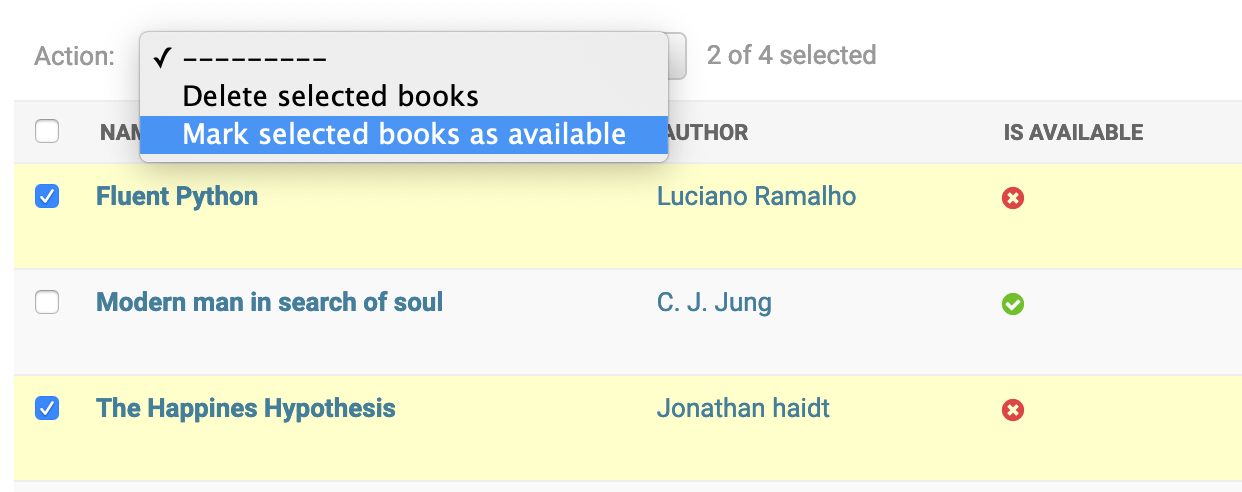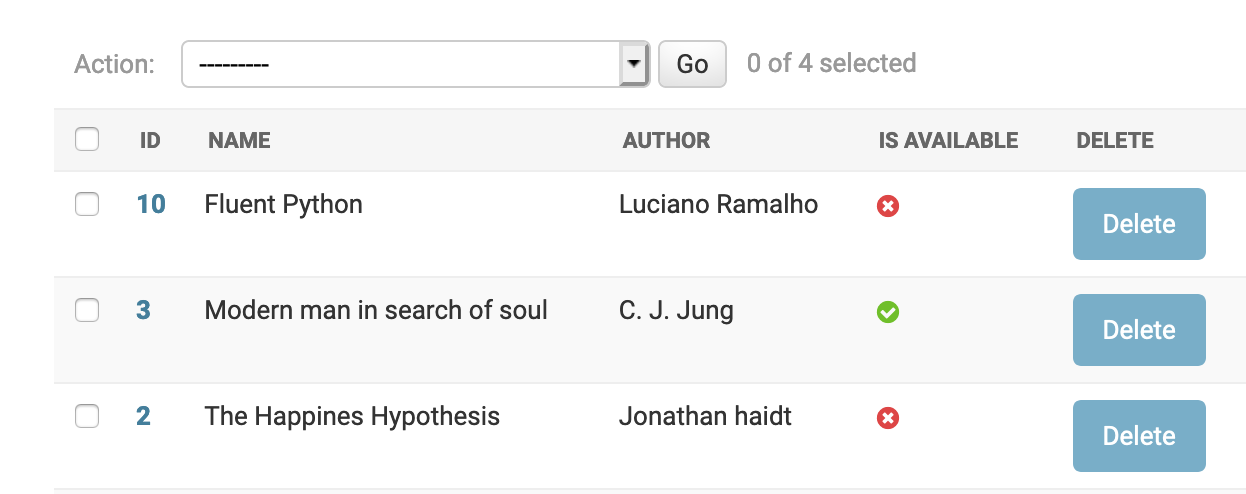Custom Admin Actions¶
Bulk Editing In List View¶
For data cleanup and heavy content updates, bulk editing on a model makes workflow easier. Django provides list_editable option to make selected fields editable in the list view itself.
class BestSellerAdmin(RelatedFieldAdmin):
list_display = ('id', 'book', 'year', 'rank')
list_editable = ('book', 'year', 'rank')
This allows to edit the above mentioned fields as shown.

Custom Actions On Querysets¶
Django provides admin actions which work on a queryset level. By default, django provides delete action in the admin.
In our books admin, we can select a bunch of books and delete them.

Django provides an option to hook user defined actions to run additional actions on selected items. Let us write write a custom admin action to mark selected books as available.
class BookAdmin(admin.ModelAdmin):
actions = ('make_books_available',)
list_display = ('id', 'name', 'author')
def make_books_available(self, modeladmin, request, queryset):
queryset.update(is_available=True)
make_books_available.short_description = "Mark selected books as available"

Instead of having custom actions in the drop down, we can put dedicated butons for most frequently used actions to reduce number of clicks needed to perform an action.
Custom Actions On Individual Objects¶
Custom admin actions are inefficient when taking action on an individual object. For example, to delete a single user, we need to follow these steps.
Select the checkbox of the object.
Click on the action dropdown.
Select “Delete selected” action.
Click on Go button.
Confirm that the objects needs to be deleted.
Just to delete a single record, we have to perform 5 clicks. That’s too many clicks for a single action.
To simplify the process, we can have delete button at row level. This can be achieved by writing a function which will insert delete button for every record.
ModelAdmin instance provides a set of named URLs for CRUD operations. To get object url for a page, URL name will be {{ app_label }}_{{ model_name }}_{{ page }}.
For example, to get delete URL of a book object, we can call reverse(“admin:book_book_delete”, args=[book_id]). We can add a delete button with this link and add it to list_display so that delete button is available for individual objects.
from django.contrib import admin
from django.utils.html import format_html
from book.models import Book
class BookAdmin(admin.ModelAdmin):
list_display = ('id', 'name', 'author', 'is_available', 'delete')
def delete(self, obj):
view_name = "admin:{}_{}_delete".format(obj._meta.app_label, obj._meta.model_name)
link = reverse(view_name, args=[book.pk])
html = '<input type="button" onclick="location.href=\'{}\'" value="Delete" />'.format(link)
return format_html(html)
Now in the admin interface, we have delete button for individual objects.

To delete an object, just click on delete button and then confirm to delete it. Now, we are deleting objects with just 2 clicks.
In the above example, we have used an inbuilt model admin delete view. We can also write custom view and link those views for custom actions on individual objects. For example, we can add a button which will mark the book status to available.
Custom Actions On Change View¶
When users want to conditionaly perform a custom action when an object gets modified, custom action buttons can be provided on the change view. For example, when a best seller is updated, notify the author of the best seller via an email.
We can override change_form.html to include a button for custom action.
{% extends 'admin/change_form.html' %}
{% block submit_buttons_bottom %}
{{ block.super }}
<div class="submit-row">
<input type="submit" value="Notify Author" name="notify-author">
</div>
{% endblock %}
In the admin view, we have to override response_change to handle the submit button press.
class BestSellerAdmin(admin.ModelAdmin):
change_form_template = "bestseller_changeform.html"
def response_change(self, request, obj):
if "notify-author" in request.POST:
send_best_seller_email(obj)
self.message_user(request, "Notified author abouthe the best seller")
return HttpResponseRedirect(request.path_info)
return super().response_change(request, obj)
This will show a button on the change form as shown below.

Add confirmation page for potentialy dangerous actions.
There is a 3rd party package django-admin-row-actions, which provides a mixin to create custom admin actions.
https://github.com/DjangoAdminHackers/django-admin-row-actions
In this chapter, we have seen how to write custom admin actions which work on single item as well as bulk items.